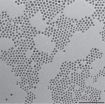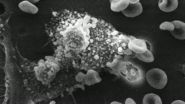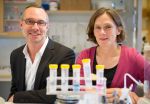(Press-News.org) The excessive atmospheric carbon dioxide that is driving global climate change could be harnessed into a renewable energy technology that would be a win for both the environment and the economy. That is the lure of artificial photosynthesis in which the electrochemical reduction of carbon dioxide is used to produce clean, green and sustainable fuels. However, finding a catalyst for reducing carbon dioxide that is highly selective and efficient has proven to be a huge scientific challenge. Meeting this challenge in the future should be easier thanks to new research results from Berkeley Lab.
Peidong Yang, a chemist with Berkeley Lab's Materials Sciences Division, led a study in which bimetallic nanoparticles of gold and copper were used as the catalyst for the carbon dioxide reduction. The results experimentally revealed for the first time the critical influence of the electronic and geometric effects in the reduction reaction.
"Acting synergistically, the electronic and geometric effects dictate the binding strength for reaction intermediates and consequently the catalytic selectivity and efficiency in the electrochemical reduction of carbon dioxide," Yang says. "In the future, the design of carbon dioxide reduction catalysts with good activity and selectivity will require the careful balancing of these two effects as revealed in our study."
Yang, who also holds appointments with the University of California (UC) Berkeley and the Kavli Energy NanoSciences Institute at Berkeley, is a leading authority on nanoparticle phenomena. His most recent research has focused on nanocatalysts fashioned from metal alloys rather than a single metal such as gold, tin or copper.
"By alloying, we believe we can tune the binding strength of intermediates on a catalyst surface to enhance the reaction kinetics for the carbon dioxide reduction," he says. "Nanoparticles provide an ideal platform for studying this effect because, through appropriate synthetic processes, we can access a wide range of compositions, sizes and shapes, allowing for a deeper understanding of catalyst performance through precise control of active sites."
In addition, Yang says, nanoparticle as catalysts have high surface-to-volume and surface-to-mass ratios that are advantageous for achieving high catalytic activity. For this new study, uniform gold–copper bimetallic nanoparticles with different compositions were assembled into ordered monolayers then observed during carbon dioxide reduction.
"The ordered monolayers served as a well-defined platform that enabled us to better understand their fundamental catalytic activity in carbon dioxide reduction," Yang says. "Based on our observations, the activity of the gold-copper bimetallic nanoparticles can be explained in terms of the electronic effect, in which the binding of intermediates can be tuned using different surface compositions, and the geometric effect, in which the local atomic arrangement at the active site allows the catalyst to deviate from the scaling relation."
The effects Yang and his colleagues observed for gold-copper bimetallic nanoparticles should hold true for other carbon dioxide reduction catalysts as well.
"We expect the effects we observed to be universal for a wide range of catalysts, as evidenced in other areas of catalysis such as the hydrogen evolution and oxygen reduction reactions," says Dohyung Kim, a member of Yang's research group and a collaborator in this study. "The factors we have identified are based on the solid concept of electrocatalysis."
Knowing the influence of the electronic and geometric effects makes it possible to deduce how intermediate products in the reduction of carbon dioxide, such as carboxylic acid and carbon monoxide, will interact with the surface of a newly proposed catalyst and thereby provide the means for predicting the catalyst's performance. Coupled with the exceptional structuring of active catalytic sites made possible by the use of nanoparticles, the path is paved, Yang and his colleagues believe, for unprecedented improvements in electrochemical carbon dioxide reduction.
"My group is now using the insights gained from this study in the design of next generation carbon dioxide reduction catalysts," Yang says.
A paper describing this research has been published in Nature Communications entitled "Synergistic geometric and electronic effects for electrochemical reduction of carbon dioxide using gold–copper bimetallic nanoparticles." Yang is the corresponding author and Kim is the lead author. The other co-authors are Joaquin Resasco, Yi Yu and Abdullah Mohamed Asiri.
INFORMATION:
Lawrence Berkeley National Laboratory addresses the world's most urgent scientific challenges by advancing sustainable energy, protecting human health, creating new materials, and revealing the origin and fate of the universe. Founded in 1931, Berkeley Lab's scientific expertise has been recognized with 13 Nobel prizes. The University of California manages Berkeley Lab for the U.S. Department of Energy's Office of Science. For more, visit http://www.lbl.gov.
On the road to artificial photosynthesis
Berkeley Lab study reveals key catalytic factors in carbon dioxide reduction
2014-09-25
ELSE PRESS RELEASES FROM THIS DATE:
Study: Widespread vitamin D deficiency in thyroidectomy patients
2014-09-25
DETROIT – A new study from researchers at Henry Ford Hospital in Detroit finds widespread vitamin D deficiency among patients who undergo a thyroidectomy, potentially putting them at greater risk for developing dangerously low blood calcium levels after surgery.
Among the patients in the Henry Ford study, 40 percent had low vitamin D levels prior to surgery. Those more likely to be vitamin D deficient are individuals older than age 50, African Americans, Hispanics and patients undergoing surgery for hyperthyroidism.
"The issue of vitamin D deficiency in patients who ...
How to make stronger, 'greener' cement
2014-09-25
CAMBRIDGE, Mass--Concrete is the world's most-used construction material, and a leading contributor to global warming, producing as much as one-tenth of industry-generated greenhouse-gas emissions. Now a new study suggests a way in which those emissions could be reduced by more than half — and the result would be a stronger, more durable material.
The findings come from the most detailed molecular analysis yet of the complex structure of concrete, which is a mixture of sand, gravel, water, and cement. Cement is made by cooking calcium-rich material, usually limestone, ...
BUSM researchers find NAS treatment needs standardization
2014-09-25
(Boston) – When it comes to treating infants with neonatal abstinence syndrome (NAS), researchers from Boston University School of Medicine (BUSM) believe the care for these infants should be consistent and objective, with standardized assessment tools and evidence to back up pharmacologic and nonpharmacologic treatment choices.
The review paper, which is published online in Addiction Science & Clinical Practice, highlights the need for more research in this field to optimize care for both infants and their mothers.
NAS is a collection of signs and symptoms infants ...
Fecal microbiota transplantation recommended for treatment of C. difficile
2014-09-25
(Vienna, October 26, 2014) The transplantation of faecal microbiota from a healthy donor has been shown in recent clinical studies to be a safe and highly effective treatment for recurrent Clostridium difficile (C. difficile) infection and is now recommended in European treatment guidelines.1,2 Faecal microbiota transplantation (FMT) has emerged as a revolutionary, potentially life-saving treatment for this common, difficult-to-treat infection, and is showing promise in the management of other microbiota-related conditions.3,4
Presenting at the 22nd United European Gastroenterology ...
In the face of uncertainty, the brain chooses randomness as the best strategy
2014-09-25
AUDIO:
Editor Karen Carniol interviews Dr. Alla Karpova on her latest Cell paper.
Click here for more information.
Past experience is usually a reliable guide for making decisions, but in unpredictable and challenging situations, it might make more sense to take risks. A study published by Cell Press September 25th in the journal Cell shows that, in competitive situations, rats abandon their normal tactic of using past experience to make decisions and instead make random choices ...
How the brain gains control over Tourette syndrome
2014-09-25
Tourette syndrome is a developmental disorder characterized by involuntary, repetitive, and stereotyped movements or utterances. Now researchers reporting in the Cell Press journal Current Biology on September 25 have new evidence to explain how those with Tourette syndrome in childhood often manage to gain control over those tics. In individuals with the condition, a portion of the brain involved in planning and executing movements shows an unusual increase compared to the average brain in the production of a primary inhibitory neurotransmitter known as GABA.
The paradoxical ...
Modified vitamin D shows promise as treatment for pancreatic cancer
2014-09-25
VIDEO:
Salk scientists find that a vitamin D-derivative makes tumors vulnerable to chemotherapy.
Click here for more information.
LA JOLLA—A synthetic derivative of vitamin D was found by Salk Institute researchers to collapse the barrier of cells shielding pancreatic tumors, making this seemingly impenetrable cancer much more susceptible to therapeutic drugs.
The discovery has led to human trials for pancreatic cancer, even in advance of its publication today in the journal ...
How physical exercise protects the brain from stress-induced depression
2014-09-25
Physical exercise has many beneficial effects on human health, including the protection from stress-induced depression. However, until now the mechanisms that mediate this protective effect have been unknown. In a new study in mice, researchers at Karolinska Institutet in Sweden show that exercise training induces changes in skeletal muscle that can purge the blood of a substance that accumulates during stress, and is harmful to the brain. The study is being published in the prestigious journal Cell.
"In neurobiological terms, we actually still don't know what depression ...
Brain chemical potential new hope in controlling Tourette Syndrome tics
2014-09-25
A chemical in the brain plays a vital role in controlling the involuntary movements and vocal tics associated with Tourette Syndrome (TS), a new study has shown.
The research by psychologists at The University of Nottingham, published in the latest edition of the journal Current Biology, could offer a potential new target for the development of more effective treatments to suppress these unwanted symptoms.
The study, led by PhD student Amelia Draper under the supervision of Professor Stephen Jackson, found that higher levels of a neurochemical called GABA in a part ...
Super enhancers in the inflamed endothelium
2014-09-25
Boston, MA – Normally, the lining of blood vessels, or endothelium, when at rest, acts like Teflon, ignoring the many cells and other factors rushing by in the bloodstream. In response to inflammatory signals, as well as other stimuli, endothelial cells change suddenly and dramatically—sending out beacons to attract inflammatory cells, changing their surface so those cells can stick and enter tissues, and initiating a complex cascade of responses essential to fighting infection and dealing with injury. Unfortunately, these same endothelial responses also promote atherosclerosis, ...
LAST 30 PRESS RELEASES:
Statins significantly reduce mortality risk for adults with diabetes, regardless of cardiovascular risk
Brain immune cells may drive more damage in females than males with Alzheimer’s
Evidence-based recommendations empower clinicians to manage epilepsy in pregnancy
Fungus turns bark beetles’ defenses against them
There are new antivirals being tested for herpesviruses. Scientists now know how they work
CDI scientist, colleagues author review of global burden of fungus Candida auris
How does stroke influence speech comprehension?
B cells transiently unlock their plasticity, risking lymphoma development
Advanced AI dodel predicts spoken language outcomes in deaf children after cochlear implants
Multimodal imaging-based cerebral blood flow prediction model development in simulated microgravity
Accelerated streaming subgraph matching framework is faster, more robust, and scalable
Gestational diabetes rose every year in the US since 2016
OHSU researchers find breast cancer drug boosts leukemia treatment
Fear and medical misinformation regarding risk of progression or recurrence among patients with breast cancer
Glucagonlike peptide-1 receptor agonists and asthma risk in adolescents with obesity
Reviving dormant immunity: Millimeter waves reprogram the immunosuppressive microenvironment to potentiate immunotherapy without obvious side effects
Safety decision-making for autonomous vehicles integrating passenger physiological states by fNIRS
Fires could emit more air pollution than previously estimated
A new way to map how cells choose their fate
Numbers in our sights affect how we perceive space
SIMJ announces global collaborative book project in commemoration of its 75th anniversary
Air pollution exposure and birth weight
Obstructive sleep apnea risk and mental health conditions among older adults
How talking slows eye movements behind the wheel
The Ceramic Society of Japan’s Oxoate Ceramics Research Association launches new international book project
Heart-brain connection: international study reveals the role of the vagus nerve in keeping the heart young
Researchers identify Rb1 as a predictive biomarker for a new therapeutic strategy in some breast cancers
Survey reveals ethical gaps slowing AI adoption in pediatric surgery
Stimulant ADHD medications work differently than thought
AI overestimates how smart people are, according to HSE economists
[Press-News.org] On the road to artificial photosynthesisBerkeley Lab study reveals key catalytic factors in carbon dioxide reduction



